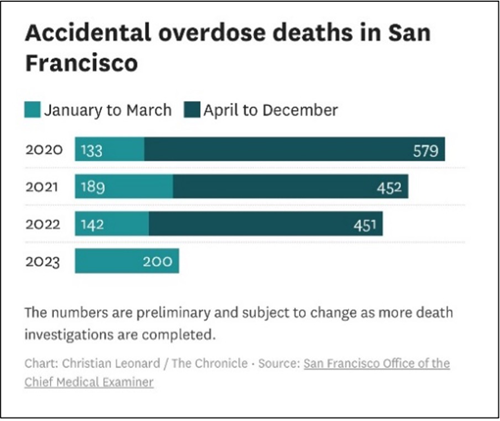San Francisco, CA — The San Francisco Office of the Chief Medical Examiner has released their Report on Accidental Overdose Deaths for the first three months of this year. The preliminary number of accidental overdose deaths in March 2023 is 66, which brings the total accidental overdose deaths this year to 200. According to the San Francisco Chronicle, this represents a staggering 41 percent increase in accidental overdose deaths compared to the same period in 2022.[1] The city is currently far outpacing its record overdose mortality rates seen in each of the past three years.

Over the last nine months, San Francisco officials began increased enforcement and arrests of people who use drugs,[2] and have increased charging rates while reducing opportunities for diversion.[3] This approach is counterproductive – it further isolates people who use drugs and makes it harder for people to access the care they need.[4] This isolation directly contributes to increased overdose deaths, in addition to the other negative health outcomes, such as hospitalizations and decreased initiations of medications for opioid use disorder.[5]
University of California San Francisco (UCSF) attributed this increase in deaths largely to the closure of the Tenderloin Center in December 2022, where staff reversed more than 330 overdoses. Per the San Francisco Chronicle, Dr. Daniel Ciccarone, a professor of family and community medicine at UCSF, believes the Tenderloin Center, despite its flaws, prevented deaths and helped people who use drugs feel more comfortable seeking treatment. “We simply didn’t let the project last long enough to see the benefits,” Ciccarone said.[6]
While the date compared from the past quarter constitutes a small sample size over a three-month period, despite the uptick in punitive approaches to people who use drugs, an obvious contributing factor to the increase in overdose deaths between January and March in 2023 versus the same period in 2022 in San Francisco was the closure of the Tenderloin Center. Nationally, fatal overdoses have continuously climbed over this same period for the last several years as the inclusion of fentanyl in the illicit drug supply has been largely responsible for these overdoses.
New York City, which began operating the first two overdose prevention centers (OPCs) in the United States in November 2021, recognizing the value of these stigma-free entry points into whole person care, has since announced an intention to increase their number of OPCs from two to five by 2025.[7] Rhode Island is expected to follow suit and has approved over $2 million in opioid settlement funds to help establish OPCs.[8]
The need for OPCs in San Francisco is undeniable, and every day we delay opening OPCs citywide at least two more people in the city needlessly die of an accidental overdose. With the rising rates of overdose deaths, the city must take action to address this public health crisis.
To be successful in responding to the overdose crisis, there must be low-barrier welcoming locations that include overdose prevention services. If we want people to not use drugs in public and on the streets, and more importantly, to not die from drug overdoses, we must continue to support voluntary services that build connections with people and provide direct access to services and care.
About HealthRIGHT 360:
HealthRIGHT 360 is a non-profit provider of substance use disorder treatment, mental health services, and primary care to over 47,000 Californians annually. HealthRIGHT 360 provides care that is compassionate, non-judgmental, and evidence-based. We provide services, regardless of one’s ability to pay; inspired by our belief that healthcare is a right, not a privilege. Learn more about HealthRIGHT 360 and our programs at http://www.healthright360.org
[1] Leonard, C. “‘Enormous rise’ in San Francisco overdose deaths in 2023,” San Francisco Chronicle, April 19, 2023. https://www.sfchronicle.com/sf/article/drug-overdose-deaths-2023-17904060.php
[2] Cassidy, M., Neilson, S. “Is S.F. law enforcement cracking down on drug users? Top officials are sending mixed messages,” San Francisco Chronicle, July 22, 2022. https://www.sfchronicle.com/sf/article/Is-S-F-law-enforcement-cracking-down-on-drug-17323749.php
[3] Neilson, S. “Brooke Jenkins has transformed San Francisco’s crime policies. Here’s what the data shows,” San Francisco Chronicle, March 29, 2023. https://www.sfchronicle.com/bayarea/article/san-francisco-arrests-jail-17837526.php
[4] Volkow, N. “Punishing Drug Use Heightens the Stigma of Addiction,” NIDA, August 9, 2021. https://nida.nih.gov/about-nida/noras-blog/2021/08/punishing-drug-use-heightens-stigma-addiction
[5] Barocas, J.A., Nall, S.K., Axelrath, S., et al. “Population-Level Health Effects of Involuntary Displacement of People Experiencing Unsheltered Homelessness Who Inject Drugs in US Cities,” JAMA Network, April 10, 2023. https://jamanetwork.com/journals/jama/article-abstract/2803839
[6] Leonard, 2023.
[7] Hogan, B., “New York City wants to have five new ‘safe injection’ sites by 2025,” New York Post, March 2, 2023. https://nypost.com/2023/03/02/nyc-wants-to-have-five-new-safe-injection-sites-by-2025/
[8] Mulvaney, K., “$2.25M from opioid settlement dedicated to help RI create safe drug consumption site,” The Providence Journal, July 22, 2022. https://www.providencejournal.com/story/news/courts/2022/07/22/opioid-settlement-funding-ri-safe-drug-consumption-harm-reduction-centers/10126536002/
